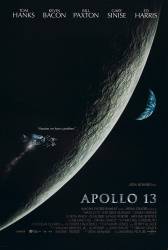Factual error: When Lovell's daughter is complaining that the Beatles have broken up, she slams the album Let It Be into her rack. The scene takes place on the day of the initial explosion aboard Apollo 13, April 13 1970 - immediately prior to the Lovell family attending the screening of a television broadcast from the spacecraft. Let It Be was not released as an album until May 9th, 1970. In April Ringo was still recording drum tracks, not even possible for an advance copy to get out.

Apollo 13 (1995)
0 reviews
Directed by: Ron Howard
Starring: Tom Hanks, Ed Harris, Kevin Bacon, Bill Paxton, Gary Sinise
Your rating
Average rating
(14 votes)
More mistakes in Apollo 13
Gene Kranz: I don't care about what anything was *designed* to do. I care about what it *can* do.
Trivia: The exchange between Lovell and his wife about holidays ("you know that Easter vacation? There's been a change of destination ... how about the moon?") in fact took place in 1968, when Lovell was assigned to Apollo 8 and so missed his planned Christmas vacation.
More questions & answers from Apollo 13





Answer: Spacecraft re-enter Earth's atmosphere at extremely high velocity (thousands of miles per hour). Atmospheric friction slows the spacecraft descent somewhat; but, without parachutes, the Apollo spacecraft would still reach the surface traveling at hundreds of miles per hour. Landing in water at such high speed would be like hitting concrete, which would of course be instantly fatal. Hence the necessity of multiple parachutes. The Apollo program (and all early U.S. manned space programs) chose to land in the ocean for two reasons: 1) It was easier to track spacecraft re-entry from horizon-to-horizon at sea without visual and radar obstacles, and; 2) It was faster and easier to position several Navy vessels in the general splashdown location, then deploy helicopters to rapidly retrieve the astronauts and their spacecraft.
Charles Austin Miller